Diamond
Diamonds are amongst the most sought-after gems for their elegance, brilliance, and permanence. There are 4 key factors to choosing a diamond: Clarity, Colour, Cut, and Carat. Get to know these factors better and choose the diamond that suits you best.
Yellow is the most prominent and popular colour of gold, yet changing trends and tastes have induced an increase in demand for rose and white gold too.
Cut
Cut refers to the proportions, symmetry, finish, and polish of a diamond. These are factors that influence the brilliance and reflective qualities of the diamond. A poor cut generally refers to a cut which has offensive ridges that may interfere with the finished appearance of the diamond. A poor cut will muffle the brilliance, or sparkle, or a diamond, by preventing light from being dispersed evenly. The cut is the only one of the 4 Cs that is determined by artistry and not by nature.
An excellent diamond cut produces a diamond with a high light return, dazzling brilliance, fire and scintillation. A poor cut, on the other hand, can cause light to seep out of the sides and bottom of the diamond or it can limit the amount of light that enters a diamond. Poor cuts can therefore cause the diamond to appear dark, dull and lifeless, despite its color and clarity grades. This fact makes a diamond's cut the most significant factor to influence appearance. For this reason, Dhandapani Jewellery suggests that you choose the diamond with the highest cut grade that falls within your budget.

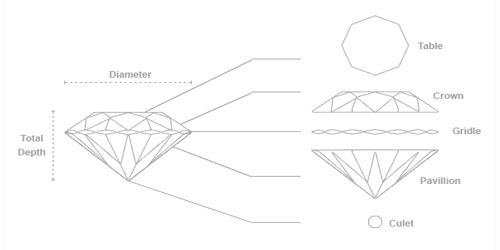
The cut of a diamond influences three main qualities:
Brilliance
Brilliance is the total amount of light reflected by a diamond. When light hits the diamond's surface, some light enters and some is reflected back. The most immediate light reflected back is returned by the crown's angles.
Scintillation
Scintillation refers to the flashes of light, or sparkles, which are produced when a diamond is tilted from side to side. The light that isn't immediately reflected back enters the diamond and reflects from the inside walls toward the center of the diamond. This light, which bounces off the internal walls of the diamond, is the quality described as scintillation.
Fire
A diamond's fire refers to the dispersion of light into different colored light. Once the light is bounced off the inside walls towards the center of the diamond, it then shoots back through the top of the diamond. Because the light is slightly bent by the diamond, a color spectrum is visible when light exits the top of the diamond.
Understanding Diamond Anatomy
To properly understand a diamond's cut, it is important to understand the terminology of basic diamond structure as it relates to proportion, symmetry and polish.
Diameter: The diameter is the width of a polished diamond from one side of the girdle to another.
Table: The table is the largest polished facet of the diamond on the top face of the stone.
Crown: The crown is the top part of the diamond that is measured from the surface of the table to the girdle.
Girdle: The girdle is the widest edge of the diamond where the crown ends and meets the pavilion.
Pavilion:The pavilion is the bottom part of the diamond that begins at the girdle and extends downward to the point of the culet.
Culet: The culet is the tiny flat facet at the bottom tip of the diamond.
Depth: The depth of a diamond refers to the total length of a diamond, measured from the culet to the table.
Proportion, Symmetry and Polish
Diamond Proportion
To optimally capture light and reflect it back, a diamond's pavilion must have accurate angles and depth. If the angle of the pavilion is too shallow or too deep, light will escape or leak out, creating dark and dull "stains." The crown angle is also extremely important since this affects the way that light enters and exits the diamond.
Not only are the angles important, but depth percentage and table percentage are also key factors that contribute to the quality of a diamond's cut. Depth percentage refers to the depth of the diamond divided by its diameter. Shallower diamonds have low depth percentages whereas deeper diamonds have higher depth percentages. A good target depth percentage for a round diamond is considered to fall between 59 and 62.5%. Table percentage refers to the width of the table divided by the diameter. Again, diamonds with a higher table percentage have larger tables, and diamonds with a smaller table percentage have smaller tables. A good target depth percentage for a round diamond is considered to fall between 53 and 59%.
Diamond Symmetry
A diamond's facets must be symmetrical in order to maximize the amount of light that enters and exits the stone. Diamonds with poor symmetry look slightly distorted, unbalanced and improperly shaped. Moreover, they will affect brilliance, scintillation and fire. Many asymmetrical round stones are not completely round, or have misshapen facets or off-center culets. Dhandapani Jewellery recommends that you consider round brilliant diamonds with a symmetry grade no lower than Very Good, and fancy cut diamonds with a symmetry grade no lower than Good.
Diamond Polish
Once a diamond is cut, each facet of the diamond is polished. If the polishing is done improperly, it can leave scratches and streaks that are similar to the marks left behind after a car waxing. An Excellent diamond polish is a diamond which has very few or no scratches.Dhandapani Jewellery recommends that you consider diamonds with a polish grade no lower than Good.
Cut Grades
- Ideal/ Excellent – Excellent light performance. Reflects almost all of the light that enters. Rare and extremely beautiful cuts.
- Very Good – Very good light performance. Reflects almost all of the light that enters. Very Good diamond cuts are considered to be an outstanding value.
- Good – Good light performance. Reflects most of the light that enters. Good diamond cuts are far less pricey than Very Good cuts.
- Fair – Not as brilliant as a Good cuts or above, Fair diamond cuts are still considered good quality diamonds.
- Poor – Poor cut diamonds are typically cut too shallow or too deep causing much of the light to leak out of the diamond's sides and base. Most high end diamond retailers do not carry Poor cut diamonds.
Color
Color refers to the color scale of white diamonds, or the color or colors of fancy diamonds. White diamonds can be completely colorless, or have a yellowish tone, but even the most yellow of white diamonds is far less colorful than a fancy yellow diamond. The less color a white diamond contains, the more valuable it is, and the more highly rated it will be on the color scale. Fancy diamond colors include red, blue, pink, green, orange, yellow, black and brown, and one diamond may include more than one color. Fancy diamonds, being rarer than white diamonds, may be more valuable, depending on their level of purity and size.
There are exceptions to the rule however. For example, diamonds with pointed ends, specifically marquis, radiant’s, trillion, pear and sometimes even princess shaped diamonds tend to focus the color on these points. In this case, it is usually best to stay with a color grade of H and higher. However, if you have a pronged setting, the prongs will usually hide this color concentration In addition, when you are perhaps looking for a loose center diamond for a 3 stone ring, it is important to make sure that the color ranges are at least within 1 grade of each other.

Color Grading
When grading a diamond's color, the stone is examined face-down under carefully controlled light. The diamond's color is then compared to a "master stone" which has a predetermined diamond color.
The Gemological Institute of America's (GIA) color grading system is the diamond industry's standard for diamond color grading. The GIA's color grading system begins with D, being the whitest, and continues through the alphabet to Z, for stones that are yellowish or brownish. Before the GIA developed their universal diamond color grading standard several other diamond color scales were being used by the international diamond community. The GIA's intention was to completely differentiate their new system from the others. As such, they chose letters D-Z, letters that had never been used for diamond grading before.
Diamond Color
- D 100% Colorless. The highest color grade a diamond can receive. D graded diamonds are extremely rare and very highly priced.
- E,F Colorless. Exceptionally transparent. Extremely difficult to detect the traces of color in an E or F graded diamond. These diamonds are rare and highly priced.
- G,H Nearly Colorless. Unless these diamonds are compared next to a master stone of higher color grade, color is nearly indiscernible. When face up these diamond appear nearly colorless. These diamonds are still rare, but slightly less expensive and are considered a good value.
- I,J Nearly Colorless. Color in these diamonds is slightly detectable. The slight amount of color is imperceptible by the unaided eye once the diamond has been mounted. These diamonds are of superior value, and therefore compose the majority of diamonds that are used for engagement rings, earrings and pendants.
- K-M Faint Yellow. Noticeable color, although some diamonds in this range can still be fiery and beautiful.
- N-Z Very Light or Light Yellow. Noticeable color. These diamonds are not fit to be sold as gemstones, unless you specifically would like to have a diamond with an amber color.
What is Fluorescence?
Many diamonds, when placed under UV light, emit a light glow in the same way that a white T-shirt does. Because there are a small amount of UV rays in regular daylight, some diamonds also exhibit fluorescence in natural light. On more recent GIADiamond Grading Reports, the fluorescence of a diamond appears as a graded characteristic. Fluorescence can be graded as Inert, Faint, Medium, or Strong. To this day there is still no consensus among industry experts regarding the general impact of fluorescence on a diamond. This is because strong fluorescence in a diamond with a high color grade (D-H) can cause the diamond to appear milky or cloudy, while strong fluorescence in a diamond with a low color grade can make the diamond appear whiter. Most of the time, fluorescence has no impact on a diamond's appearance under regular lighting conditions.
Clarity
Clarity in diamonds refers to their clearness and purity, how many impurities or blemishes occur both on the inside and on the surface of a diamond, and where they are positioned. A perfectly clear diamond is the most desirable, and will have the highest clarity rating. Every imperfection or color flaw inside or outside the diamond will diminish its level of clarity, and therefore its value. Even fancy colored diamonds have clarity ratings, and have a heightened value based on how perfect and even they are, and how many or few blemishes they include.

What Are Inclusions?
The internal irregularities in a diamond are the diamonds' inclusions. Inclusions typically consist of crystals, clouds and feathers. Crystals are tiny minerals that become trapped inside a diamond during its formation. Clouds are foggy spots in the diamond which are created by crystals that are so small that they can only be seen under a 10x magnifying microscope. Feathers are fractures in a stone that, when relatively small, are inconsequential to the strength of a diamond. Large feathers, however, can weaken a diamond's structure, and will decrease the value and quality of your diamond.
What Are Blemishes?
Blemishes are external impurities or marks on the surface of a diamond, and typically appear as a scratch imperceptible to the naked eye. Blemishes typically have less impact on a diamond's value, beauty and grade since they rarely affect the strength and structure of the diamond. FL/IF | VVS1 | VVS2 | VS1 | VS2 | SI1 | SI2 | I1 | I2-3
Clarity Grading
The Gemological Institute of America's (GIA) International Diamond Grading System™ is the globally recognized standard for diamond clarity assessment. With 11 grades, the system classifies a diamond's clarity based on the nature, position and size of its inclusions and exclusions. The list below summarizes the GIA's International Diamond Grading System. Diamonds with the least amount of flaws hold the highest clarity grading. Flawless diamonds are extremely rare, considered to be the most beautiful of all diamond grades. Because they are so scarce diamond experts consider Internally Flawless diamonds (IF) to be the most valuable examples of near-perfection in the international diamond market.
Trained gemologists grade the clarity of a diamond by examining it top-down with the use of a 10x magnifying microscope and looking at the diamond from the top down. The position, size and type of inclusions and blemishes are all crucial factors in evaluating the clarity of a diamond. Imperfections located on or beneath the table of the diamond are easier to detect and affect clarity grade more than those located around the sides of the diamond. Larger marks, darker marks, and deep marks will also significantly affect the clarity of the diamond.
FL, IF Flawless/Internally Flawless: Flawless diamonds have no inclusions or blemishes detectable under 10x magnification, and are extremely rare. Internally flawless diamonds have no detectable inclusions under 10x magnification, are rare and very valuable.
VVS1/VVS2 Very Very Slightly Included: Inclusions and blemishes are extremely difficult for a skilled grader to detect under 10 x magnification.
VS1/VS2 Very Slightly Included: Inclusions and blemishes are detectable under 10x magnification, however they are minor flaws that do not impact the diamond's beauty and are frequently invisible to the naked eye.
SI1/SI2 Slightly Included: Inclusions and blemishes are easily noticeable under 10x magnification and may also be visible to the naked eye.
I1, I2, I3 Included: Inclusions and blemishes are obvious under 10x magnification and typically visible to the naked eye. These flaws may negatively impact the transparency and or brilliance of the diamond.
Carat Weight
Carat refers to the weight of a diamond. The term itself is derived from the Carob fruit, whose evenly weighted seeds were used long ago as a comparative measurement for the weighing of diamonds and other small, but valuable, items. Contrary to popular belief, carat weight is not directly correlated to the size or a diamond. One carat is equal to 0.20 grams, and is subdivided into 100 points. Larger diamonds are rarer than small diamonds, which means that each subsequent carat of weight makes a diamond successively more expensive with the value per carat increasing with the size of the diamond. An obvious example for this is that 0.50 carat diamonds are worth less than a single 1 carat diamond due to the natural rarity of larger rough diamonds.
A carat is the unit of weight used to measure diamonds and other precious gemstones, also known as the carat size or the diamond carat size. The term carat is derived from the Greek word keration, meaning carob beans. In the Mediterranean, carob beans were used for centuries to measure the weight of various goods. This is because carob seeds were thought to be uniform in size and weight. In contrast, Asian markets used grains of rice to measure their goods and you may still hear some jewelers refer to a single carat diamond as a "four grainer" since one carat was once considered to be equal to the weight of four grains of rice. By the early 1900s, the carat size was standardized against the metric system and adopted internationally: 1 carat (1ct) is equal to .2 grams or .007 ounces. Smaller diamonds can also be measured in carat weight points. One carat is equal to 100 points; therefore a 0.25 carat diamond can also be referred to as a 25 point diamond.
Does Carat Weight Determine Size?
Contrary to popular belief, carat weight is not an accurate reflection of a diamond's size, the carat size. A diamond increases in weight much faster than it increases in diameter. While small round diamonds that have the same carat weight are almost indistinguishable in size, the heavier a diamond gets, the less predictable its size is.
In order to determine a diamond's size, the carat weight of the stone should be weighed in conjunction with the diamond's diameter in millimeters and the diamond's cut grade. The diamond's diameter measured in millimeters reflects the appearance of the diamond as seen from above once the stone is mounted. It is measured across the girdle of the stone, and does not incorporate the height of the pavilion.
Some low carat diamonds with high grade cuts look larger than high carat diamonds with low grade cuts. Diamonds with higher cut grades reflect the maximum amount of light and generate the greatest fire and brilliance. This bright sparkle and intense luminescence can frequently cause the diamond to appear larger than it is, to create the impression of a large diamond carat size. Moreover, diamonds with lower cut grades can have long and deep pavilions that cause light to "leak out", dulling and muting the stone's radiance. These long pavilions may add weight to a diamond, but this weight is covered beneath the setting once the stone is mounted, making the diamond carat size appear much smaller. Viewers of diamonds such as these may be surprised by how small the stones appear in comparison to their carat weight.
Carat Weight and Price
Diamond prices rise drastically with increase in carat weight. This is because only one in approximately one million diamonds mined produces a full cut and polished one carat diamond. During the cutting process, a great deal of rough diamond material is lost; up to 40-60 percent of rough diamond is shed. The larger diamond, the rarer the diamond, the more expensive.
What Carat Weight Should I Choose?
Every diamond wearer has different criteria regarding their diamond, popular carat sizes vary greatly. Some value diamond carat size over clarity, others value color over carat weight. At Zoara we believe that the most important things to consider are personal taste, budget, and for a diamond ring, the setting and size of the finger or hand of the wearer. Personal Taste: Decide which of the Four Cs is the most important to you. Some are sensitive to brilliance and sparkle more than size. Others prefer large vintage-style diamonds which are typically less radiant, but greater in carat size.
Budget: If you are looking for a larger stone but you’re on a budget, you can try to maximize the appearance of the stone by investing in the stone's cut and choosing a brilliant shape. You may instead prefer to invest in a stone of high carat weight but with lower clarity, color and cut grades. Choosing a large diamond carat size over a large carat weight
Setting: Diamonds that are longer in shape such as a marquis, pear, or rectangular emerald, can create the illusion of a larger diamond. Also, if a diamond is mounted into a high-pronged setting such as the tiffany setting or the tall prong setting, it can make a stone look larger. Finally, adding side accent stones of low carat and lower quality can be an affordable way to enlarge the ring and total carat weight.
Finger Size: Small diamonds appear larger on small hands and vice-versa. Large diamonds can look clumsy on small or slender fingers. For a woman with small and thin fingers, you may want to consider a diamond of lower carat weight and a lower carat size.
What is Total Carat Weight?
Total carat weight (ctw) refers to the total weight of all diamonds set in the jewellry item. For example, in order to calculate the TCW of a three stone ring, one would take into consideration the center diamond as well as the two side stones.
Shape
The 10 universally recognized diamond shapes that we know today are relatively recent innovations, created and given a theoretic, public platform beginning only in the early 20th century. The 14th century marked the start of European diamond cutting novelties that yielded shapes, while being the predecessors of today's cuts, are unknown to the modern-day diamond consumer: The Point Cut, Old Eight Cut, Pendeloque, Briolette, Rosette, Mazarin, and Peruzzi. These advances were the stepping stones to today's 10 contemporary diamond cuts, the global diamond industry's accepted standards.
As part of Dhandapani Jewellery's unfailing involvement in thoroughly educating our customers before, during, and after your diamond purchase, we are delighted to present the following diamond shape guide within the scope of our Diamond Learning Guide. Each diamond shape has specific and unique characteristics that influence the quality of the diamond. To help you decide what shape best suits your taste, take a look below at the different qualities of each distinct diamond shape.
We invite you to look, learn, and marvel. And if you have any questions about diamond shapes, please contact our Diamond Experts.

Round

The round brilliant diamond is the most popular and perhaps the most technically advanced of all of the diamond shapes. Only after the development of new diamond cutting technology and a breakthrough in research regarding proportion and symmetry, was the round brilliant born. The round brilliant that we know today was invented by Marcel Tolkowsky, a Belgian mathematician born to a family of diamond cutters who, in 1919, wrote his doctoral thesis on diamond proportion and symmetry, and "invented" the round brilliant. According to his research, the round brilliant, with its 58 facets, has the perfect proportions and symmetry to maximize a diamond's brilliance and fire. This superior quality, therefore, allows for those interested in the round brilliant to be quite flexible regarding the other qualities of their diamond: color, cut and clarity.
Princess

What is the ideal cut for a princess diamond?
Princess cut diamonds are the second most popular diamond for engagement rings after round brilliant diamonds, and are valued because of their terrific value and appearance. However, unlike round diamonds, the princess diamond lacks a standardized cut grading, so therefore the GIA or other diamond grading agencies will not grade the cut on a princess diamond. So, how does one determine the ideal cut proportions for a princess diamond? Like with round brilliant diamonds, the ideal cut for a princess diamond is determined by many factors, most importantly depth and table proportions as well as crown and pavilion angles. The cut is also determined by the symmetrical arrangement of the facets on the diamond, which is simply put, how well all of the facets align with each other in a way that maximizes brilliance and fire. So what are the ideal proportions of a princess cut diamond? It is GRT Jewellers’ recommendation that for a princess diamond to have ideal proportions, its table must be within 62-68%, the depth must be 64-75% and the crown height should be 10-15%. The symmetry should also be very good to excellent.
Also, another important thing when determining the ideal cut for a princess diamond, it is crucial to take the width to length ratio into account, because this will decide how rectangular or square the diamond is. The ratio is calculated by dividing the length against the width. A perfect square princess diamond will have a ratio of 1, while a more rectangular one will be over 1.05. When searching for the perfect princess cut diamond, it is always recommended to check with one of GRT Jewellers’s certified gemologists who will be happy to suggest some excellent options for ideal princess diamonds.
Emerald

The emerald cut is not a brilliant cut, but rather features a large open table with step cuts. The emerald cut is traditionally rectangular and most closely resembles the natural diamond shape. Although the emerald diamond is not as brilliant as the round shape or princess shape, it is considered to be an elegant cut, vintage in style, and less "flashy" than other shapes. Note that due to the large table of the emerald shape, inclusions and color can be easier to detect. It is recommended that you choose a diamond with a higher clarity and color grade than you would if choosing a brilliant diamond.
Asscher
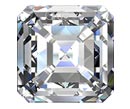
The Asscher diamond is almost indistinguishable from the emerald cut aside from its larger step facets, dramatically cut corners and square shape. Also, because of its proportions, it typically has more light reflection and fire than an emerald shaped diamond. As with the emerald diamond, the Asscher diamond also has a certain antique, elegant air about it. The Asscher diamond, similar to the princess diamond, can sometimes show color impurities in its corners. Therefore, although the price for an Asscher diamond with lower color grade can be enticing, we recommend choosing one with an H color grade or higher.
Oval
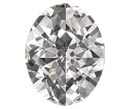
The oval diamond is a modified round brilliant shape. While this means that it has a high level of brilliance, if the stone is not a premium cut, there is a greater likelihood of the bowtie effect, or a dark strip that appears in the center of the stone in the shape of a bowtie. GRT Jewellers carries only quality cut oval diamonds with optimally cut angles.
Marquise
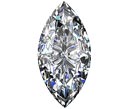
The shape of the marquise diamond was allegedly inspired by the mouth of the beautiful Marquise de Pompadour. It has a football-like shape that comes to a point on either end, which is said to maximize the illusion of increased diamond weight, giving the appearance of a much larger-looking diamond. A modification of the round brilliant, the marquise shape also offers a high level or brilliance and light reflection, and due to its long, lean frame, marquise diamonds are frequently set with side stones.
Radiant
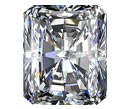
The radiant shape was the first diamond of rectangular shape to have a brilliant facet pattern used both for the crown and pavilion, offering a brighter and more brilliant stone than the emerald shape. The radiant shape was born over decades ago and is considered to be the father of 'fancy cut' diamonds. The proportioning, facet arrangement and shape of the radiant diamond is considered a good shape for colored diamonds since it is widely held that these factors intensify color.
Heart

The heart shaped diamond is a modified brilliant diamond shape and can vary greatly in length and width. The heart shape, with its classic connotation of romance and love, is a popular choice for anniversary rings and Mother's Day necklaces. GRT Jewellers recommends that when shopping for a heart shaped diamond you should look for a stone that is perfectly symmetrical: Where the top arches of the heart are even in height and width so that its overall shape is aesthetically pleasing. The cleft in any well-cut heart shaped diamond should be sharp and definite. Also, the heart shaped diamond, similar to the princess shape, can sometimes show color impurities at its corners. Therefore, although the price for a heart shaped diamond with lower color grade can seem inviting, we recommend choosing a heart shaped diamond with an H color grade or higher.
Pear
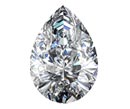
The pear shaped diamond is also a modified brilliant shape, a combination of the round and marquis shapes. It is also known as a teardrop shape for its round bottom and sides which taper to one common point. Some of the world's most famous and most highly graded diamonds have been cut into the pear shape. An elongated pear shape is also considered a specifically flattering shape when worn mounted on a ring with the point facing upwards towards the nail, thus creating an apparent slimming effect of the finger.
Cushion
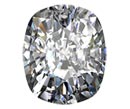
The cushion shaped diamond is technically known as the Old Mine Cut, a shape born before the 1900s. It developed its name due to its similarity to the shape of a pillow and is therefore also known as the "pillow cut". The cushion shaped diamond was one of the most popular diamond shapes before the invention of the round brilliant. Once the round brilliant was developed, the brilliant angles and proportions were incorporated into the cushion shape. The cushion shape has rounded corners and now features larger facets, which increase the brilliance of the stone. It should also be noted that the cushion shape is a popular choice for fancy colored diamonds since the color is displayed evenly throughout cushion shaped diamonds. It should be noted that the large facets of a cushion diamond can make it easier to detect inclusions in the stone. It is therefore recommended that those in the market for a cushion diamond choose a color grade of I or greater and a clarity grade of S1 or higher.

